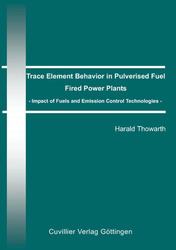| Departments | |
|---|---|
| Book Series (96) |
1378
|
| Nachhaltigkeit |
3
|
| Gesundheitswesen |
1
|
| Humanities |
2363
|
| Natural Sciences |
5406
|
| Engineering |
1791
|
| Engineering | 292 |
| Mechanical and process engineering | 861 |
| Electrical engineering | 686 |
| Mining and metallurgy | 30 |
| Architecture and civil engineering | 75 |
| Common |
98
|
|
Leitlinien Unfallchirurgie
5. Auflage bestellen |
|
Advanced Search
Trace Element Behaviour in Pulverised Fuel Fired Power Plants (English shop)
Impact of Fuels and Emission Control Technologies
Harald Thorwarth (Author)Preview
Table of Contents, Datei (36 KB)
Extract, Datei (68 KB)
Fossil as well as renewable biomass fuels contain trace elements. Those are fed to the combustion process with the fuel. During combustion they are fully or partially evaporated in the furnace. Depending on the concentration in the fuels, the individual properties of the trace elements, the flue gas composition and the applied air pollution control devices (APCDs), trace elements are emitted at the stack at different concentrations.
The present work describes the trace element behaviour in pulverised fuel fired power plants. The main focus of the investigations is laid on the impact of air pollution control devices and biomass secondary fuels. Experimental investigations have been carried out at a 500KWth test facility firing different coals and the secondary fuels straw and sewage sludge. Mercury is of special interest due to its high vapour pressure. Hence, additional lab-scale investigations have been carried out studying the impact of SCR-DeNOx catalysts and metal oxides.
The experiments show that trace elements can be released to the gas phase and condense on fly ash particles along the flue gas path, depending on their volatility. The use of secondary fuels influences the trace element enrichment in different ash fractions. Mercury (Hg) is the only element studied in this work that is completely evaporated during combustion. Along the flue gas path Hg adsorbs to fly ash particles, but it can be also present in the gas phase at the stack in significant concentrations. Mercury behaviour in ash filtering systems and flue gas desulphurisation plants (FGD) is also influenced by mechanisms at the SCR catalyst. The results show for different investigated catalyst elements that the NOx reduction and mercury oxidation are competing reactions. Associated to this effect, elemental mercury is desorbed from the active sites of the catalyst when ammonia is injected to start the NOx reduction mechanism. Related to the chlorine concentration, co-firing secondary fuels can improve mercury oxidation at the catalyst and can therefore improve the mercury removal in a downstream flue gas desulphurisation plant.
| ISBN-13 (Printausgabe) | 386727343X |
| ISBN-13 (Hard Copy) | 9783867273435 |
| ISBN-13 (eBook) | 9783736923430 |
| Final Book Format | A5 |
| Language | English |
| Page Number | 146 |
| Lamination of Cover | glossy |
| Edition | 1 |
| Volume | 0 |
| Publication Place | Göttingen |
| Place of Dissertation | Stuttgart |
| Publication Date | 2007-08-23 |
| General Categorization | Dissertation |
| Departments |
Mechanical and process engineering
|
| Keywords | Trace Elements, Mercury, Ash, Combustion, Coal, Biomass, Flue Gas Cleaning, SCR-DeNOx Catalyst, Electrostatic Precipitator (ESP), Fabric Filter, Flue Gas Desulphurisation (FGD), Emissions. |








